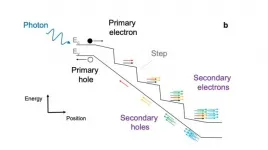(Press-News.org) Realizing the potential of self-driving cars hinges on technology that can quickly sense and react to obstacles and other vehicles in real time. Engineers from The University of Texas at Austin and the University of Virginia created a new first-of-its-kind light detecting device that can more accurately amplify weak signals bouncing off of faraway objects than current technology allows, giving autonomous vehicles a fuller picture of what's happening on the road.
The new device is more sensitive than other light detectors in that it also eliminates inconsistency, or noise, associated with the detection process. Such noise can cause systems to miss signals and put autonomous vehicle passengers at risk.
"Autonomous vehicles send out laser signals that bounce off objects to tell you how far away you are. Not much light comes back, so if your detector is putting out more noise than the signal coming in you get nothing," said Joe Campbell, professor of electrical and computer engineering at the University of Virginia School of Engineering.
Researchers around the globe are working on devices, known as avalanche photodiodes, to meet these needs. But what makes this new device stand out is its staircase-like alignment. It includes physical steps in energy that electrons roll down, multiplying along the way and creating a stronger electrical current for light detection as they go.
In 2015, the researchers created a single-step staircase device. In this new discovery, detailed in Nature Photonics, they've shown, for the first time, a staircase avalanche photodiode with multiple steps.
"The electron is like a marble rolling down a flight of stairs," said Seth Bank, professor in the Cockrell School's Department of Electrical and Computer Engineering who led the research with Campbell, a former professor in the Cockrell School from 1989 to 2006 and UT Austin alumnus (B.S., Physics, 1969). "Each time the marble rolls off a step, it drops and crashes into the next one. In our case, the electron does the same thing, but each collision releases enough energy to actually free another electron. We may start with one electron, but falling off each step doubles the number of electrons: 1, 2, 4, 8, and so on."
The new pixel-sized device is ideal for Light Detection and Ranging (lidar) receivers, which require high-resolution sensors that detect optical signals reflected from distant objects. Lidar is an important part of self-driving car technology, and it also has applications in robotics, surveillance and terrain mapping.
Adding steps increases sensitivity and consistency of the device. And the consistent multiplication of electrons with each step makes the electrical signals from the detector more dependable, even in low light conditions.
"The less random the multiplication is, the weaker the signals you can pick out from the background," said Bank. "For example, that could allow you to look out to greater distances with a laser radar system for autonomous vehicles."
This type of sensing capability has existed for decades, but technological barriers held back its advancement. Photomultiplier tubes long represented the "holy grail" of this form of sensing, Bank said, but that technology has been around for more than 50 years and uses outdated lighting components and vacuum tubes. In the 1980s, inventor Federico Capasso first conceived of the avalanche photodiode technology the researchers have been studying. But the tools and techniques to make it a reality just weren't far enough along.
The science behind this breakthrough comes in a new way of growing materials, Bank said. Instead of growing materials with randomly distributed atoms, they created layered alloys composed of binary compounds -- those made up of two elements -- stacked on top of each other.
"What this allows is to change the electron's energy landscape in a very simple way to create the structure that Capasso envisioned in the early 80s, but unfortunately there just wasn't the ability to synthesize crystals that had all the requisite properties," Bank said.
Another important piece of this device is that it can operate at room temperature. Today, the most sensitive light detectors need to be kept at temperatures hundreds of degrees below zero, making them too expensive and impractical for applications such as lidar.
The research was funded by the U.S. Army Research Office (ARO) and The Defense Advanced Research Projects Agency (DARPA). The researchers have funding through ARO and DARPA to continue refining their process to add even more steps to the devices. And they are working with a semiconductor company to commercialize the technology.
The engineers also plan to marry their multi-step staircase device with an avalanche photodiode they built last year that is sensitive to near-infrared light, which opens up new applications such as fiber-optic communications and thermal imaging.
"This should give us the best of both worlds: response to a wider range of colors and greater sensitivity to weak signals because of the lower noise amplification that comes naturally from the staircase architecture," Bank said.
INFORMATION:
Scientists from Queen Mary University of London and Rothamsted Research have used radar technology to track male honeybees, called drones, and reveal the secrets of their mating behaviours.
The study suggests that male bees swarm together in specific aerial locations to find and attempt to mate with queens. The researchers found that drones also move between different congregation areas during a single flight.
Drones have one main purpose in life, to mate with queens in mid-air. Beekeepers and some scientists have long believed that drones gather in huge numbers of up to 10,000 in locations known as 'drone congregation areas'. Previous research has used pheromone lures to attract drones, raising concerns ...
What The Study Did: These preliminary findings using U.S. Centers for Disease Control and Prevention Vaccine Adverse Events Reporting System data in the early phase of societal COVID-19 vaccination using two messenger RNA vaccines suggest that no association exists between inoculation with a SARS-CoV-2 messenger RNA vaccine and incident sudden hearing loss.
Authors: Eric J. Formeister, M.D., M.S., of the Johns Hopkins University School of Medicine in Baltimore, is the corresponding author.
To access the embargoed study: Visit our For The Media website at this link https://media.jamanetwork.com/
(doi:10.1001/jamaoto.2021.0869)
Editor's Note: Please see the article for additional information, ...
What The Study Did: Researchers assessed associations between prenatal, early postnatal or current exposure to secondhand smoke and symptoms of attention-deficit/hyperactivity disorder (ADHD) among school-age children in China.
Authors: Li-Wen Hu, M.D., Ph.D., and Guang-Hui Dong, M.D., Ph.D., of Sun Yat-sen University in Guangzhou, China, are the corresponding authors.
To access the embargoed study: Visit our For The Media website at this link https://media.jamanetwork.com/
(doi:10.1001/jamanetworkopen.2021.10931)
Editor's Note: The article includes funding/support disclosures. Please see the article for additional information, including other authors, author contributions ...
BOSTON - Screening for colorectal cancer - the second most common cause of cancer-related death in the United States - can save lives by detecting both pre-cancerous lesions that can be removed during the screening procedure, and colorectal cancer in its early stages, when it is highly curable.
Screening is most commonly performed with endoscopy: visualization of the entire colon and rectum using a long flexible optical tube (colonoscopy), or of the lower part of the colon and rectum with a shorter flexible tube (sigmoidoscopy).
This week, the United States Preventive Services Task Force (USPSTF) lowered the recommended beginning age for screening from 50 to 45 for persons without a family history of colorectal ...
The discovery of a new species of ancient turtle is shedding light on hard-to-track reptile migrations about 100 million years ago. Pleurochayah appalachius, a bothremydid turtle adapted for coastal life, is described in a new paper published by a multi-institution research group in the journal Scientific Reports.
P. appalachius was discovered at the Arlington Archosaur Site (AAS) of Texas, which preserves the remnants of an ancient Late Cretaceous river delta that once existed in the Dallas-Fort Worth area and is also known for discoveries of fossil crocodyliformes and dinosaurs. P. appalachius belonged to an extinct lineage of pleurodiran (side-necked) ...
For many engineers and scientists, nature is the world's greatest muse. They seek to better understand natural processes that have evolved over millions of years, mimic them in ways that can benefit society and sometimes even improve on them.
An international, interdisciplinary team of researchers that includes engineers from The University of Austin has found a way to replicate a natural process that moves water between cells, with a goal of improving how we filter out salt and other elements and molecules to create clean water while consuming less energy.
In a new paper published today in Nature Nanotechnology, researchers created a molecule-sized water transport channel that can carry water between cells while excluding protons ...
Self-organizing heart organoids developed at IMBA - Institute of Molecular Biotechnology of the Austrian Academy of Sciences - are also effective injury- and in vitro congenital disease models. These "cardioids" may revolutionize research into cardiovascular disorders and malformations of the heart. The results are published in the journal Cell.
About 18 million people die each year from cardiovascular diseases, making them the leading cause of fatalities globally. Moreover, the most prevalent birth defects in children pertain to the heart. Currently, a major bottleneck in understanding human heart malformations and developing regenerative therapies are missing human physiological models of the heart.
The research group of Sasha Mendjan established cardioids ...
NEW YORK, NY (May 20, 2021)--The immune nature of kidney cancer stands out when compared to other cancers: More immune cells infiltrate kidney cancers than most other solid tumors, and kidney cancer is one of the most responsive malignancies to today's immunotherapy regimens.
But despite treatment, many patients with clear cell renal carcinoma--the most common type of kidney cancer--eventually relapse and develop incurable metastatic disease.
A new study shows that the presence of a rare and previously unknown type of immune cell in kidney tumors can predict which patients are likely to have cancer recur after surgery. These cells could even ...
We observe water vapor condensing into liquid droplets on a daily basis, be it as dew drops on leaves or as droplets on the lid of a cooking pot. Since the work of Dutch physicist J.D. van der Waals in the 19th century, condensation has been understood to result from attractive forces between the molecules of a fluid.
Now, an international team of researchers has discovered a new mechanism of condensation: Even if they don't attract each other, self-propelled particles can condense by turning toward dense regions, where they accumulate. The study was published in Nature Physics.
"It's like if cars steered toward crowded areas and made the crowd even bigger," explained Steve Granick, director of the IBS Center for Soft and Living ...
Antiretroviral therapy, the common approach in the treatment of HIV, halts replication of the virus and has saved the lives of millions of people. However, for patients the drug cocktail becomes a lifetime necessity because they continue to harbor latent HIV in a small number of immune system cells. In the absence of treatment, HIV can again replicate and rebound into full blown AIDs.
A new study, however, suggests that addition of a single small molecule can rip away the cloak that shields those cells containing HIV and make them susceptible the patient's own antibodies that otherwise are not normally of much use against HIV.
For the study, a team of researchers ...



